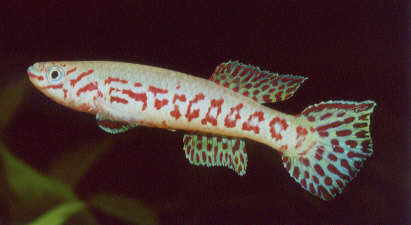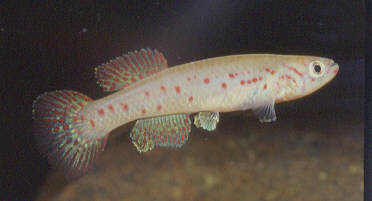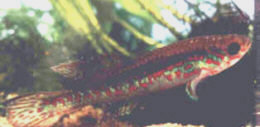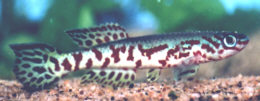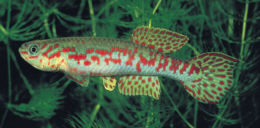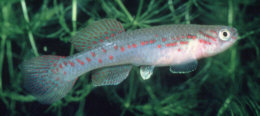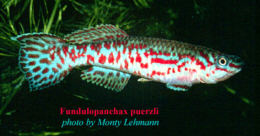Fundulopanchax puerzli (Radda & Scheel 1974)
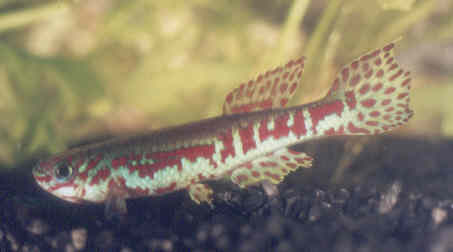
A specimen I maintained around 1982.
| Meaning of Name |
After Eduard Pürzl, collector, author, aquarist & photographer. |
||||||||||||
| First Description |
Radda A.C. & Scheel J.J. 1974. (Aphyosemion puerzli). Aphyosemion puerzli nov. spec. und Aphyosemion robertsoni nov. spec., zwei neue Rivulinen aus Kamerun. Aquarium Journal 4 (3): p 33-37, 3 figures. |
||||||||||||
| Size |
7 cm |
||||||||||||
| Meristics |
D = 13-14, A = 16, D/A = +2-3, ll = 33-34 +3-4 (Radda & Scheel 1974) |
||||||||||||
| Karyotype |
n = 20 (2n = 37-38), A = 21 (Radda & Scheel 1974, 1975). |
||||||||||||
| Sub-Genus |
Paraphyosemion |
||||||||||||
| Group |
ndianus (formerly gardneri) |
||||||||||||
| Synonyms |
|
||||||||||||
Populations
|
|
||||||||||||
| Type Locality |
27 km northeast of the Douala - Edea - Yabassi road junction in the direction of Yabassi. The biotope was a small stream near its entry into a larger tributary of the Wuri River. |
||||||||||||
| Distribution |
Western Cameroon where they inhabit the Henda, Nkwoh & Wuri River drainage systems. |
||||||||||||
| Habitat |
Rainforest swamps & shallow swampy parts of brooks & streams. Sympatric sp. include A.riggenbachi
which inhabit open water areas & are found in considerable numbers.
Fp.puerzli is found 'under heavily
shaded retreats in shallow, still inlets of small streams & in sections
of backwater'. |
||||||||||||
| Distinguishing Characteristics | Adult males have an extension in the upper rays of the caudal fin. | ||||||||||||
| Colour/Pattern Variability | Medium | ||||||||||||
| History |
Described from specimens collected in a brook in the Vouri (Wouri) River drainage 27 km north of the intersection of the Douala, Edea & Yabassi roads, Cameroon. |
||||||||||||
| Breeding Notes |
Fairly easy to breed. I used bottom mops & incubated the eggs on a layer of wet peat. Peat can also be used in the tank & taken out to dry every few weeks. Dry incubation takes 6-8 weeks with sexual maturity being attained around 2-3 months. I did find they went through periods where no eggs were layed. A lowering of the temperature can sometimes trigger spawning. First breeding attempts by Ed Pürzl report that the fish were spawned in water of 4-6 DH. Eggs were kept in moist peat & wet after 2 weeks with the result that no fry hatched. After 4 weeks a very few fry hatched. He found that after a drying period of 7-8 weeks a large number of eggs were ripe for hatching. Longer periods of dry storage produced fewer numbers of fry. Adrian Burge in BKA Killinews No.276, August
1988 had the following breeding account.. Tom Soper in the same newsletter states.. P.K.Webber in the same article as above noted that success in water incubation was determined on the age of the brood stock. He found eggs from young pairs easier to incubate in water. He found a 'definate cut off point after which only dry storage became viable'. Steve Carpenter in BKA newsletter No. 352, January 1995 used 100% rainwater, carbon filtered with 1 teaspoon of tonic salt per 2 gallons. In maintaining them the fish would stand temperatures of 79°C but for breeding this was dropped to 75°C. Eggs were laid in a bottom mop for 3 weeks when they stopped. Spawning would be periodical. The male got quite aggressive during spawning but the large female was OK. Egs were water incubated & hatched after 25 days. Fry were 3mm long. They were fed on green water to start, then micro worm, then newly hatched brine shrimp. Water changed daily. The young sex out at 5 weeks. Growth to 1 - 1·5" in 7 weeks. Jim Gasior reports breeding in BKA newsletter
No. 363, December 1995. Condition the fish seperately for 10 days. Water
waspH 7·6, DH 10°, water temperature 72°F. One floating
& two bottom mops in a bare tank. Most eggs found in bottom mops.
The male is put in the tank in the morning & the female an hour
later. Mops are checked after 4-5 hours. The fish will eat their eggs.
Eggs taken out are stored on top of moist peat. This is wetter than
you would normally use but not soaked. Breeders are seperated again
after 48 hours as males can be aggressive. Egg losses in storage are
about 50%. Greg Schoenberg in AKA Journal Nov/Dec 1981 experimented in water incubating eggs with peat extract solution. Only 10% of the eggs went bad & hatching was in 4 weeks. |
||||||||||||
| Diameter of Egg | 1·1 - 1·2 mm (Pürzl). | ||||||||||||
| Remarks |
I have had this sp. a number of times & found
they go through periods of no breeding activity despite the usual shock
tactic of reducing the water temperature, which can work when the fish
are waiting for it to happen. |
